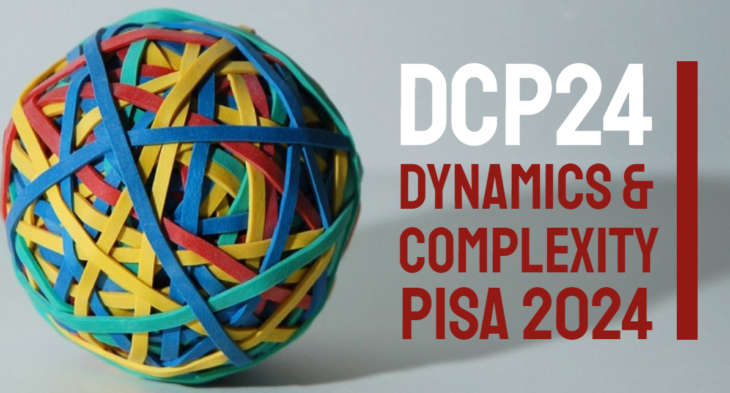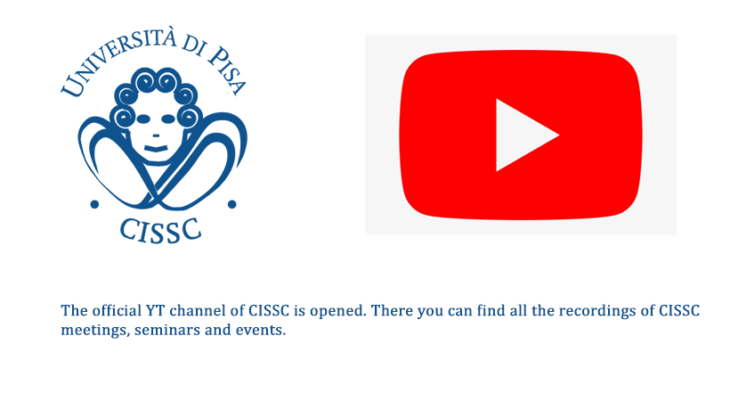Data e luogo:
5/6 Dicembre 2022, Aula Maria Curie, Palazzo D’Ancona, SNS
PARTECIPANTI:
Vincenzo Barone, Scuola Normale Superiore
Armando Bazzani, Università di Bologna
Stefano Marmi, Scuola Normale Superiore
Stefano Galatolo, Università di Pisa
Paolo Freguglia, Università degli Studi dell’Aquila
Giorgio Turchetti, Università di Bologna
Mirko Degli Esposti, Università di Bologna
Andrey Shternshis, Scuola Normale Superiore
Paolo Freguglia
Titolo: Discrete structure of a complex system. A case study: the corporate organization and development
Abstract: At first, we recall some notions related to the theory of complexity, regarding to living systems (i.e. evolution theory). Afterward we present, through the use of data collections and graph theory, a corporate structure (in itself complex) and its development. Afterward we introduces a “dynamic” that involves evaluation and information to achieve possible and reasonable corporate control.
Armando Bazzani (e Edoardo Rolando)
Titolo: Sensitivity of random walks on graphs to local failures
Abstract: The possibility of describing complex systems by network structures on which a dynamical systems is defined, has increased the interest to correlate the topological properties of the network with the dynamics. The random walks on graphs are relevant examples that can be applied to biochemical reactions or transport systems, and the evolution equation is a master equation. The problem of a link failure of a link failure may model both the effect of a damage or the rise of congested states in a transportation system. We propose to use the sensitivity concept to define a dynamical clustering in the network able to localize the failure using an incomplete observation of the network states. We illustrate the results by some numerical examples.
Giorgio Turchetti
Titolo: Risposta lineare nei sistemi dinamici: indicatori di Lyapunov ed errore di reversibilità.
Abstract: Nelle regioni di confine tra moti ordinati e caotici si sviluppa la complessità, proprietà dei sistemi viventi e di vita artificiale. Per individuare queste regioni si utilizzano gli indicatori a tempo finito che forniscono la risposta lineare ad un rumore sulle condizioni iniziali o agente durante l’evoluzione, nel limite di ampiezza nulla. L’evoluzione con rumore fino al tempo t seguita dalla evoluzione inversa fino al tempo 2t caratterizza la deviazione dalla reversibilità. La risposta lineare ai processi con rumore è specificata dalla matrice di covarianza, la cui sua traccia definisce il quadrato dell’errore di Lyapunov e di reversibilità. Anziché l’evoluzione nel tempo della traccia e
degli altri invarianti per una fissata condizione iniziale, si considera la loro variazione nello spazio della fasi a tempo fissato. Scegliendo le condizioni iniziali in un piano di fase si possono visualizzare le regioni di moto regolare, caotico e di transizione e la rete di risonanza nei sistemi hamiltoniani. Nei sistemi con dissipazione si individuano le frontiere dei bacini dei punti
attrattivi. L’efficacia di questi indicatori è stata verificata in modelli di origine
meccanica, di dinamica celeste e di particelle in un acceleratore.
Stefano Galatolo
Titolo: Self Consistent Transfer Operators in a Weak and Not So Weak Coupling Regime. Invariant Measures, Convergence to Equilibrium, Linear Response
Abstract: We describe a general approach to the theory of self consistent transfer operators. These operators have been introduced as tools for the study of the statistical properties of a large number of all to all interacting dynamical systems subjected to a mean field coupling. We consider a large class of self consistent transfer operators and prove general statements about existence of invariant measures, speed of convergence to equilibrium, statistical stability and linear response. While most of the results presented are valid in a weak coupling regime, the existence results for the invariant measures we show also hold outside the weak coupling regime. We also consider the problem of finding the optimal coupling between maps in order to change the statistical properties of the system in a prescribed way.
Mirko Degli Esposti
Titolo: Recurrence times, waiting times and universal entropy production estimators: applications to the second Chargaff’s rule for human chromosome
Abstract: The universal typical-signal estimators of entropy and cross entropy based on the asymptotics of recurrence and waiting times play an important role in information theory. Building on their construction, we introduce and study universal typical-signal estimators of entropy production in the context of nonequilibrium statistical mechanics of one-sided shifts over finite alphabets. We will discuss some applications to DNA sequences, in particular the so called second Chargaff’s rule.
Andrey Shternshis
Titolo: Shannon entropy of high frequency financial time series
Abstract: The Shannon entropy is widely used as a measure of randomness in many fields, such as physics, finance, and biology. The Shannon entropy is defined as the average amount of information that the source transmits with each symbol. I will discuss a computational methodology for a genuine estimation of the Shannon entropy. In the case of financial time series, price dynamics can be discretized and the Shannon entropy is computed over the resulting sequence of symbols. The Shannon entropy of discretized time series is estimated by the Empirical Frequencies method. In the work with S. Marmi and P. Mazzarisi (2022), we investigate dynamics of the Shannon entropy of price returns time series. To test the predictability of time series, we find the empirical quantiles corresponding to the entropy estimation of fully random processes.
The computation of the Shannon entropy for discretized price dynamics is not, however, the only step in measuring price predictability. There are regularity patterns in financial time series such as volatility clustering that tend to decrease the measure of randomness. We investigate the sources of predictability in financial time series. Using historical prices of a group of assets, we measure the degree of predictability of financial markets. We also estimate the closeness of price movements using the Kullback–Leibler distance and the entropy of price co-movements.
Stefano Marmi
Titolo: Turning lemmings into hogs:
Abstract: The Yoccoz-Birkeland (livestock) population model coupled with (random) price dynamics
Around 1996 Yoccoz and Birkeland introduced an endogenous lagged integral equation to explain the
approximately periodic but chaotic lemming population fluctuations in the Arctic ecosystem.
The evidence of cyclical but unpredictable behavior of fluctuations is also a well-known feature of
livestock product prices (hog cycle) that has attracted the attention of economists for a long time.
I will discuss deterministic and random versions of the population-market model proposed
by Arlot, Marmi, and Papini in Arlot et al. (2019).
The model is obtained by coupling the Yoccoz–Birkeland integral equation
with a demand- and supply-dependent price dynamics as in Bélair and Mackey (1989).
In the random model, we introduce a stochastic component into the price equation
inspired by the Black-Scholes market model and prove the existence of a random attractor
and a random invariant measure.
We numerically compute the fractal dimension and the entropy of the
random attractor and prove its convergence to the deterministic one
when the volatility of the market equation tends to zero.
We also numerically analyze in detail the dependence of the attractor on the choice of the
temporal discretization parameter. We implement several statistical distances
to quantify the similarity between the attractors of the discretized systems and the original ones.
In particular, following a work by Cuturi (2013), we use the Sinkhorn distance. This distance is a discrete and penalized version
of the optimal transport distance between two measures, given a transportation cost matrix.
The work on the random dynamics and the investigation of the dependence on the discretization
is joint with R. Ceccon and G. Livieri.



